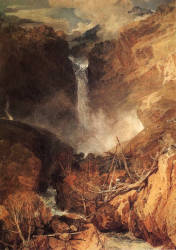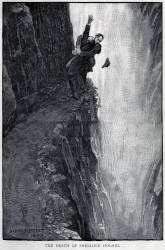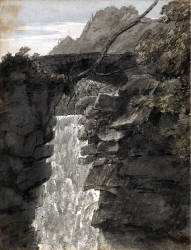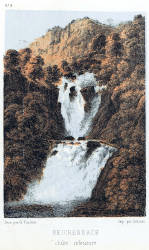Reichenbachfall
Useful Information


| Location: |
Meiringen.
From Bern take A6 motorway to Thun, then A8 motorway to the end. It becomes highway 6 along the Aare river to Meiringen. Follow signs. (46.719510, 8.187535) |
| Open: |
MAY to 10-OCT daily 9-17:30, last ascent 17:15. Every 15 minutes. [2021] |
| Fee: |
Reichenbach Falls: Return: Adults CHF 12, Children (6-15) CHF 8, Children (0-5) free. Single: Adults CHF 8, Children (6-15) CHF 6, Children (0-5) free. Gorge with Reichenbach Falls: Adults CHF 18, Children (6-16) CHF 13, Children (0-5) free. Aare Gorge: Adults CHF 10, Children (6-16) CHF 6, Children (0-5) free. Groups (10+): 1 free admission, Teachers on school trips free. [2021] |
| Classification: |
 Gorge Gorge
|
| Light: | n/a |
| Dimension: | |
| Guided tours: | self guided |
| Photography: | allowed |
| Accessibility: | no |
| Bibliography: | |
| Address: |
Grimselwelt, Grimselstrasse 19, 3862 Innertkirchen, Tel +41-33-982-26-26.
E-mail: Tourist Center Grimseltor, Grimselstrasse 2, 3862 Innertkirchen, Tel +41-33-982-26-60. E-mail: |
| As far as we know this information was accurate when it was published (see years in brackets), but may have changed since then. Please check rates and details directly with the companies in question if you need more recent info. |
|
History
| 04-MAY-1891 | "At this fearful place, Sherlock Holmes vanquished Professor Moriarty" |
| 1899 | Reichenbachfall Funicular opened. |
| 1912 | linked to Meiringen by the Meiringen–Reichenbach–Aareschlucht tramway. |
| 1918 | funicular sold to Elektrowerke Reichenbach AG in Meiringen. |
| 1926 | power station built and the railway served the operation and maintenance of this facility. |
| 1931 | technical improvement of the funicular with a new engine. |
| 1956 | tramway closed and replaced by a train connection and a bus ride. |
| 1957 | automation makes chief engineer obsolete. |
| 1976 | railway licence renewed until 2026. |
| 1999 | Reichenbachfall Funicular rebuilt in the original design. |
Description






The Reichenbachfall is actually the wrong name for this site, but thats the name under which it is famous. The reason is simple: this waterfall was the location of the death of Sherlock Holmes. The great private investigator had a fight with Dr. Moriarty on a trail at the waterfall. Then both fell down 50 m into the bed of the river, the bodies were never found.
This is the location of the finale in the Sherlock Holmes novel The Final Problem (1893). Sir Arthur Conan Doyle obviously visited Switzerland, a popular holiday destination in Victorian England. He talked with his host Sir Henry Lunn, the founder of Sir Henry Lunn Travel, who organised such trips for wealthy englishmen. When Doyle mentioned, he needed a way to kill Sherlock Holmes, Sir Henry Lunn said "Push him over the Reichenbach Falls!" Arthur Conan Doyle hadn’t heard of them, so they visited the place, and impressed he decided to let his hero die there. When Doyle wrote this story he described the place in detail. As a result there are today numerous sculptures, plates and explanatory signs about Sherlock Holmes in this area. There is even a Sherlock Holmes Trail. And in nearby Meiringen is a Sherlock Holmes Museum, you could get a reduced combo ticket for both sites.
The site is in the Aare river valley, a left tributary named Rychenbach or Reichenbach, above the town of Meiringen. At one point the steep valley wall, which was created by glaciers, is almost vertical, and the brook forms a series of waterfalls. Those waterfalls are called Reichenbachfälle (Reichenbach Falls), mind the plural. With a drop of 300 m the waterfall cascade of seven steps has three large waterfalls and many small ones. The upper fall is called Großer Reichenbachfall (Grand Reichenbach Fall) and is by far the tallest segment (120 m) and one of the highest waterfalls in the Alps. At the foot, the waterfall is up to 40 m wide and during summer 3 to 5 m³/s fall down, after heavy rainfall this increases to 30 m³/s. This is the part which is generally called Reichenbach Fall. In the night it is illuminated.
Below the upper fall, the river is dammed and collected for the Schattenhalb 1 power station during summer. As a result the lower falls are normally very low in water and by far not as impressive as on the historic pictures. During winter the water is collected in the Zwirgi dam, which is located above the falls, above the Zwirgi. This is not allowed during summer in order to protect the waterfall as a tourist site. In other words the falls are mostly dry and only the upper fall is turned on for the tourists during summer. There is also the Unterer Reichenbachfall (Lower Reichenbach Fall), which is less high but nevertheless impressive. But as the water is used to produce electricity it only trickles.
The Reichenbach Falls were the subject of several early 19th-century paintings by the English Romantic landscape painter J. M. W. Turner, better known as William Turner. Until today the falls are used as filming location, mostly for Sherlock Holmes movies. The final episode of the Benedict Cumberbatch series is called "The Reichenbach Fall" (2012) and was filmed here. But others too, for example the 2007 thriller Reichenbach Falls directed by John McKay and starring Alec Newman. Some of them were rather fantastic, in the 2011 film adaptation Sherlock Holmes: A Game of Shadows a large castle has been built over them, replacing the trail.
In the 19th century it was necessary to walk up to the waterfall, which is some 290 m above the valley floor. You can still do this today, and actually this trip is free, there is no entrance fee for the falls, only for the funicular. The funicular was built in 1899, when the number of visitors had dramatically increased, by Franz Josef Bucher from Obwalden. He was the financier of the society, and the first to recognise the falls would be an attraction for tourists, who would want to see the waterfall up close. Elias Flotron, engineer from Meiringen, applied for a federal concession for the construction. The ironworks from Roll’schen was entrusted with the construction.
It is a traditional funicular or inclined railroad with a single track with passing loop. The track is 714 m long and rises 242 m. The red cars seat 24 persons, are powered electrically and needs 7.5 minutes for the journey. From the upper station it’s a short walk to the foot of the waterfall. Trails go up to an outlook and to a small bridge across the river above the Great Fall.
The funicular was replaced by a lookalike in 1999, which works with modern technology.
It is operated by Kraftwerke Oberhasli AG (KWO) who are actually producer of hydroelectric power and operate under the name Grimselwelt.
This is a bit strange, but it seems several hydroelectric power plants they operate are great tourist sites, and actually the water of the Reichenbach is also used to produce electricity.
We have also listed the
 Kristallkluft Gerstenegg, which they discovered when they built a tunnel for water pipes.
This natural cave with rock crystals is a rather unique cave tour.
However, the funicular was sold to Elektrowerke Reichenbach AG in 1918, and when the power station was built at the falls in 1926 the funicular served the operation and maintenance of this facility.
This explains the strong connection between the funicular and the power company.
Kristallkluft Gerstenegg, which they discovered when they built a tunnel for water pipes.
This natural cave with rock crystals is a rather unique cave tour.
However, the funicular was sold to Elektrowerke Reichenbach AG in 1918, and when the power station was built at the falls in 1926 the funicular served the operation and maintenance of this facility.
This explains the strong connection between the funicular and the power company.
The site is open all year, but the funicular operates only from May to October. In winter the trails are not cleaned and might be full of snow, and also the amount of water decreases as all water is frozen, and the falls become dry. This changes in spring when the melting water starts to flow, and while a lot of water is used to produce electricity, it is still impressive. Unfortunately this early the trails are still full of snow and ice, and the visit is difficult and dangerous.
We were not sure if we should actually add this page, as showcaves.com lists gorges and cave, but this site has neither. We do not list waterfalls, although this is definitely a great geotope. We decided to make a small exception because we actually listed the nearby Aare Gorge and both sites are strongly connected. Actually they are sometimes mixed up, because both are located at Meiringen. The entrance to the Aareschlucht, which is the gorge of the Aare river, is 1.6 km from the funicular in the middle of the valley. And the waterfalls are actually the early stage of a gorge, it might take another 100,000 years but one day this will be an impressive gorge, with an enormous waterfall deep inside the gorge. You can easily see the beginning of the gorge above the Great Fall, with the Reichenbach cutting deeper and backwards.
- See also
 Search DuckDuckGo for "Reichenbachfall"
Search DuckDuckGo for "Reichenbachfall" Google Earth Placemark
Google Earth Placemark Reichenbach Falls - Wikipedia (visited: 09-OCT-2021)
Reichenbach Falls - Wikipedia (visited: 09-OCT-2021) Reichenbachfall Funicular - Wikipedia (visited: 09-OCT-2021)
Reichenbachfall Funicular - Wikipedia (visited: 09-OCT-2021) Reichenbachfall-Bahn (visited: 09-OCT-2021)
Reichenbachfall-Bahn (visited: 09-OCT-2021) Sherlock Moments in the Haslital (visited: 09-OCT-2021)
Sherlock Moments in the Haslital (visited: 09-OCT-2021) Aare Gorge and Reichenbach Falls. SBB Homepage (visited: 08-OCT-2021)
Aare Gorge and Reichenbach Falls. SBB Homepage (visited: 08-OCT-2021) RfB Reichenbachfalbahn - Funimag (visited: 09-OCT-2021)
RfB Reichenbachfalbahn - Funimag (visited: 09-OCT-2021)
 Index
Index Topics
Topics Hierarchical
Hierarchical Countries
Countries Maps
Maps